Soviet Motor Rifle Company vs West German Panzergrenadier Company, West Germany, 1988
This was a classic Central Front scenario featuring an invading Soviet force fighting its way westwards. The game tried out some features of the full Sabresquadron rules including the set-up which allowed the defending force to be dug-in and lay some mines. The attackers were allowed some programmed artillery and smoke. The defender's deployment amd attacker's entry onto the table were carried out using our new system for attack-defence games.
The West German Force (Morale - Regular, Training - Trained)
Company HQ - 2 x Rifle Groups, one is the 1 Commander.
1st Platoon - 6 x Rifle Groups, 2 Weapons Groups with Milan.
2nd Platoon - 6 x Rifle Groups, 2 Weapons Groups with Milan.
Attached Heimatzschutzkommando Tank Platoon - 3 x M48A2GA2 (Morale - Conscript, Training - Raw).
The Soviet Force (Morale - Regular, Training - Trained)
Company HQ - 1 x BTR60PB carrying 2 x Rifle Groups, one is the 1 Commander.
1st Platoon - 3 x BTR60PB each carrying 2 x Rifle Groups.
2nd Platoon - 3 x BTR60PB each carrying 2 x Rifle Groups.
3rd Platoon - 3 x BTR60PB each carrying 2 x Rifle Groups.
Support Platoon - 2 x BTR60PB carrying 2 Weapons Groups with LMG and 2 Weapons Groups with AGL.
Tank Platoon - 4 x T64BV, 1 with a mineroller.
Here is the table from the east (the Soviet entry edge) before any units were deployed:
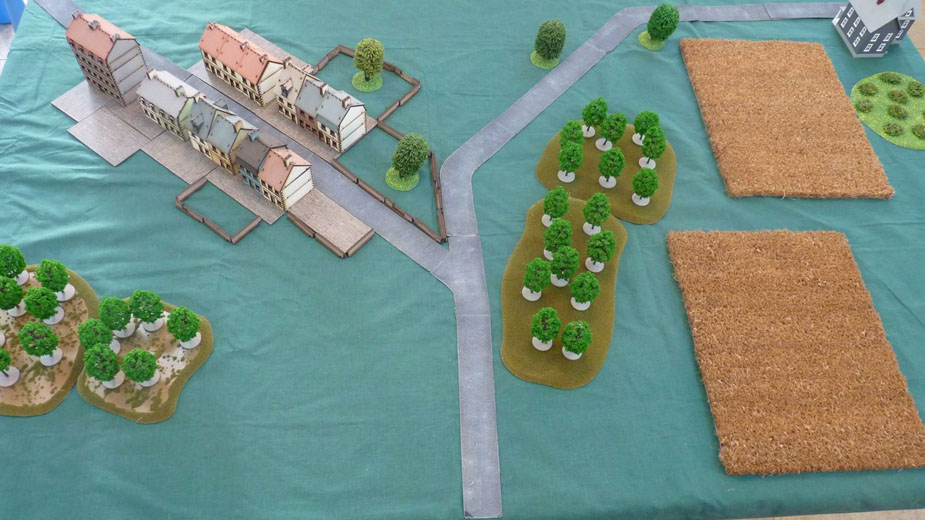 The woods were dense so prevented vehicle movement and the corn fields counted as broken ground.
The West German 2nd Platoon dug-in in front of the village.
The woods were dense so prevented vehicle movement and the corn fields counted as broken ground.
The West German 2nd Platoon dug-in in front of the village.
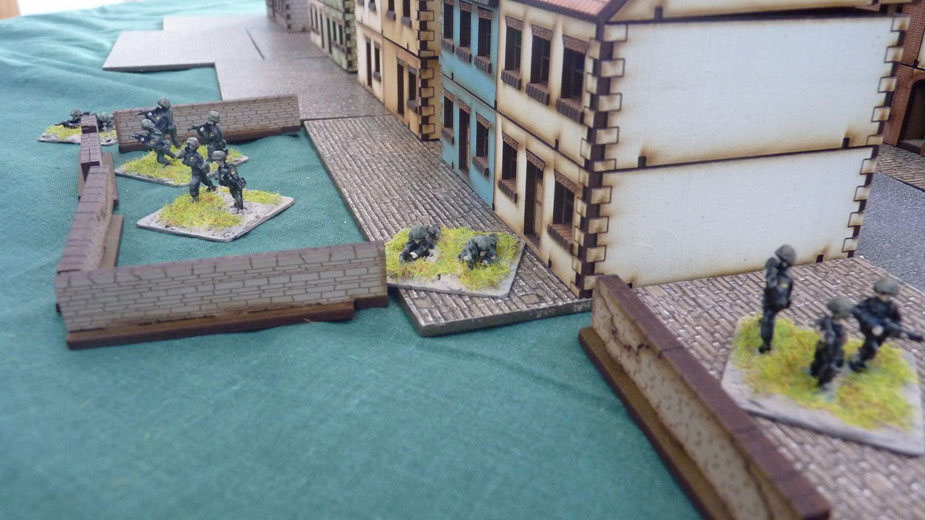
Turn 1
The Soviet programmed artillery hit the West German positions and inflicted casualties on the 2 infantry platoons.The Soviets laid smokescreens to shield advances on their right and centre. The area marked with pink tokens is the 2 West German minefields positioned side by side.
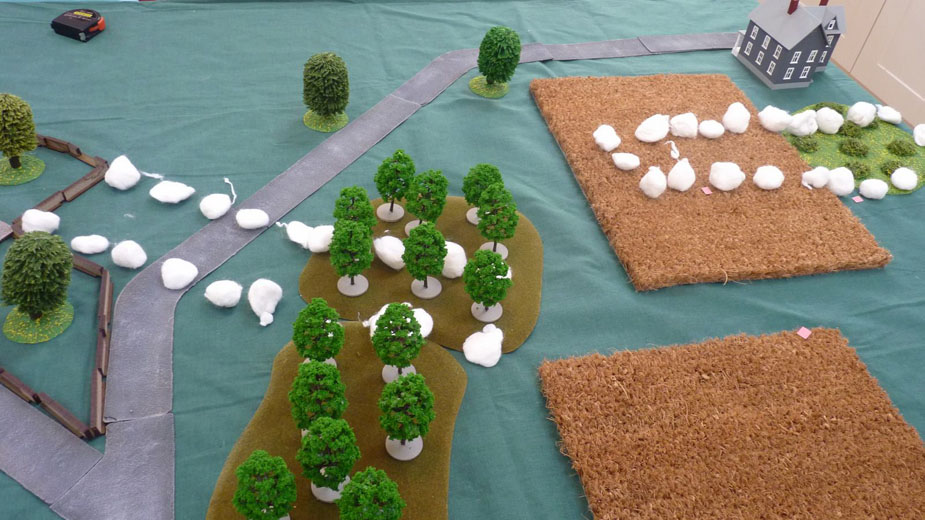 On the Soviet right the tanks led the advance aiming for the tank with minerollers to clear a path through the minefield; 3rd platoon followed behind.
On the Soviet right the tanks led the advance aiming for the tank with minerollers to clear a path through the minefield; 3rd platoon followed behind.
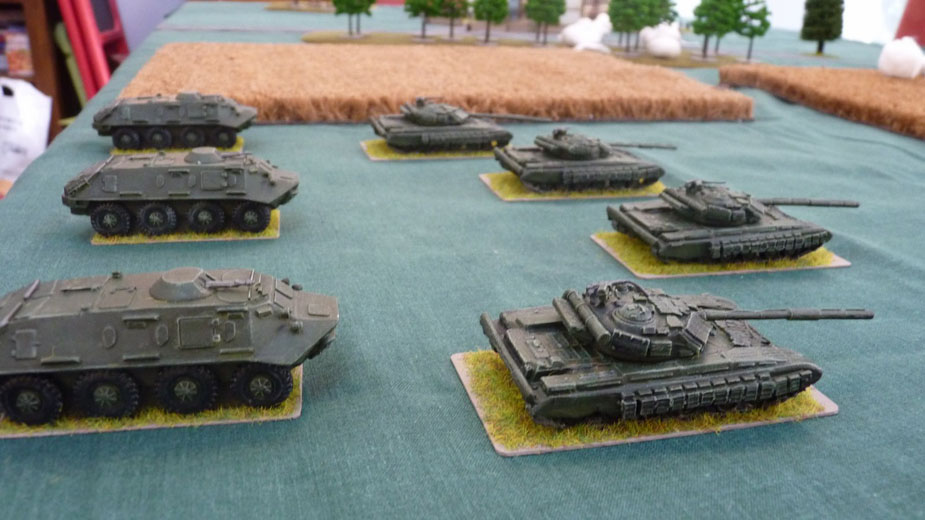 The 2nd platoon advanced in the centre shielded by smoke and the wood. The 1st platoon and the support platoon dismounted from the carriers soon after arriving on the table to attack the village in order to pin the defenders.
The 2nd platoon advanced in the centre shielded by smoke and the wood. The 1st platoon and the support platoon dismounted from the carriers soon after arriving on the table to attack the village in order to pin the defenders.
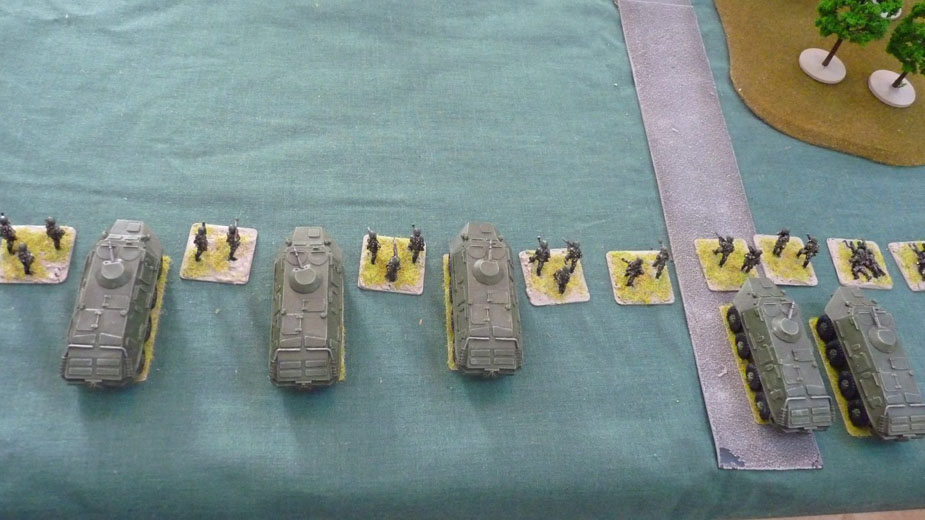 The West German M48s were placed at the back of the table behind the 1st infantry platoon. 105mm guns and Milans and opened fire on the Soviet tanks.
The West German M48s were placed at the back of the table behind the 1st infantry platoon. 105mm guns and Milans and opened fire on the Soviet tanks.
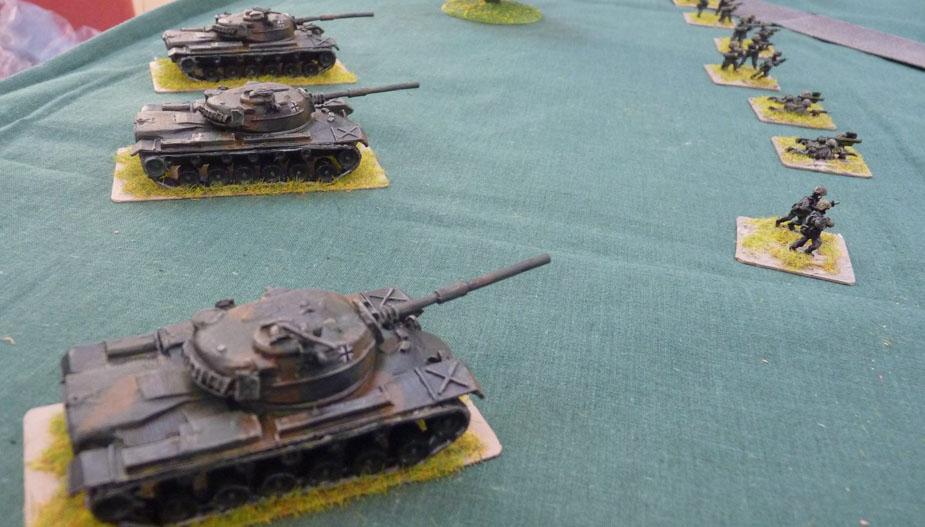 Three T64s were hit received side hits and were immediately out of action. The morale of the survivor dropped to 'Halt' preventing further advance until it could be rallied.
Three T64s were hit received side hits and were immediately out of action. The morale of the survivor dropped to 'Halt' preventing further advance until it could be rallied.
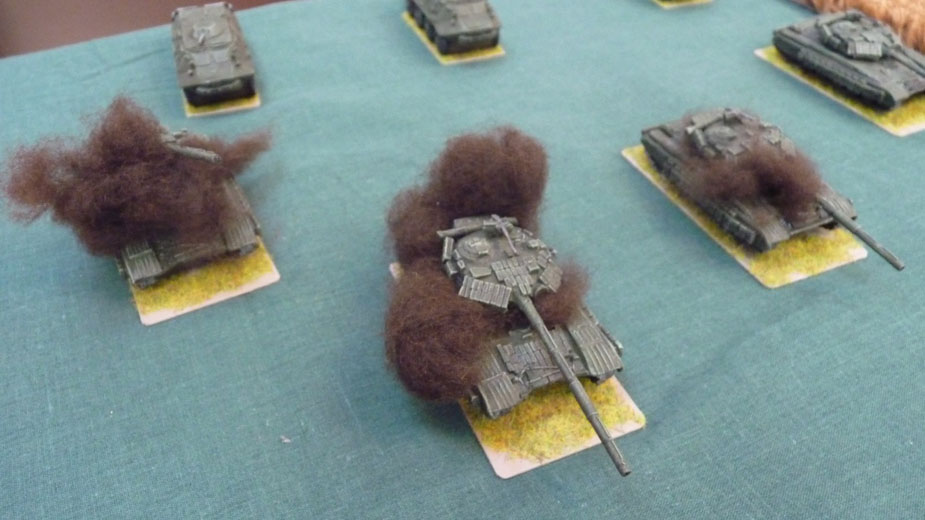 In front of the village, the West German 1st platoon opened fire on the Soviet infantry and removed 2 groups but the Milans missed the BTRs
In front of the village, the West German 1st platoon opened fire on the Soviet infantry and removed 2 groups but the Milans missed the BTRs
Turn 2
The surviving T64 delivered some rapid retaliation against the M48s by destroying one tank.
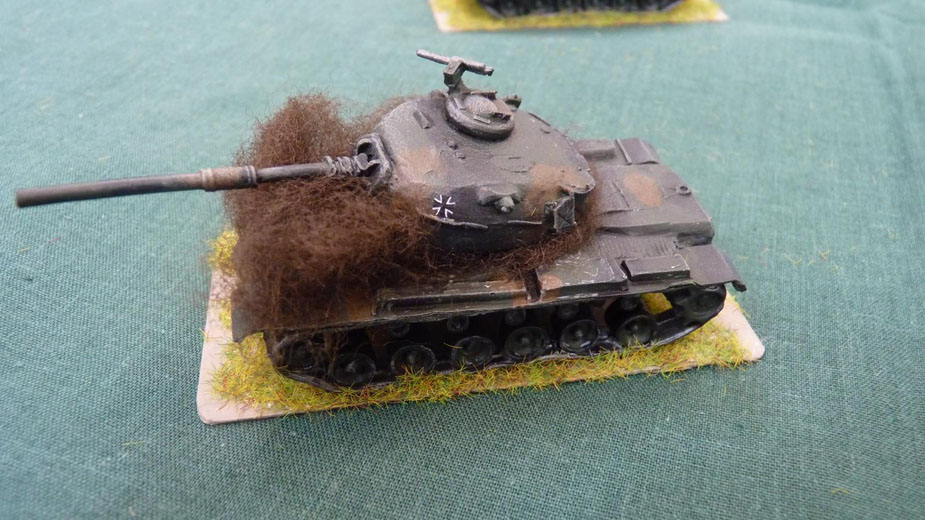 The Soviet 2nd platoon reached the central wood and the infantry dismounted.
The Soviet 2nd platoon reached the central wood and the infantry dismounted.
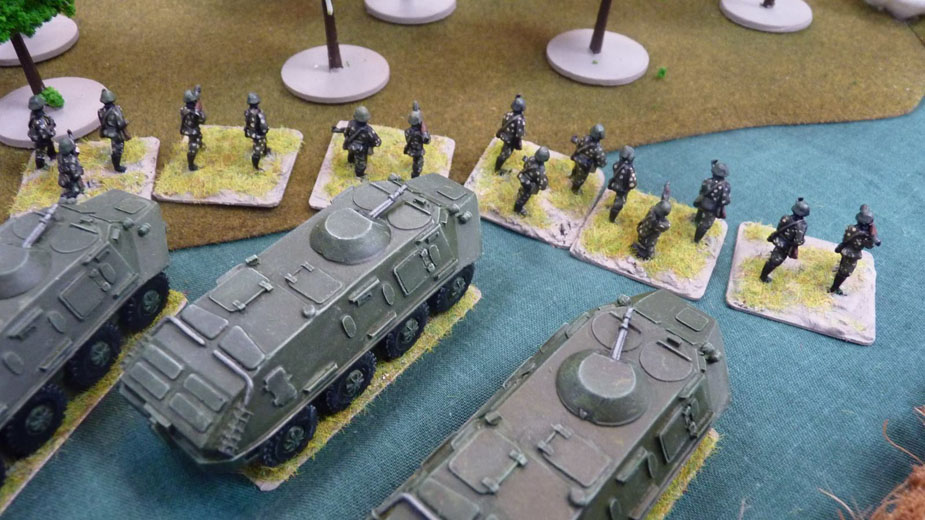 The 1st and support platoons opened fire with small arms and grenade launchers on the West German 2nd platoon inflicting a kill and 3 suppressions. This loss combined with the losses from the programmed artillery made morale plummet and the Germans were forced to withdraw back into the village. The fighting withdrawal was conducted effectively as they inflicted hits including a kill on the attacking Soviets
With the situation around the village looking critical the 2 M48s were ordered to make a quick redeployment to the right flank.
The 1st and support platoons opened fire with small arms and grenade launchers on the West German 2nd platoon inflicting a kill and 3 suppressions. This loss combined with the losses from the programmed artillery made morale plummet and the Germans were forced to withdraw back into the village. The fighting withdrawal was conducted effectively as they inflicted hits including a kill on the attacking Soviets
With the situation around the village looking critical the 2 M48s were ordered to make a quick redeployment to the right flank.
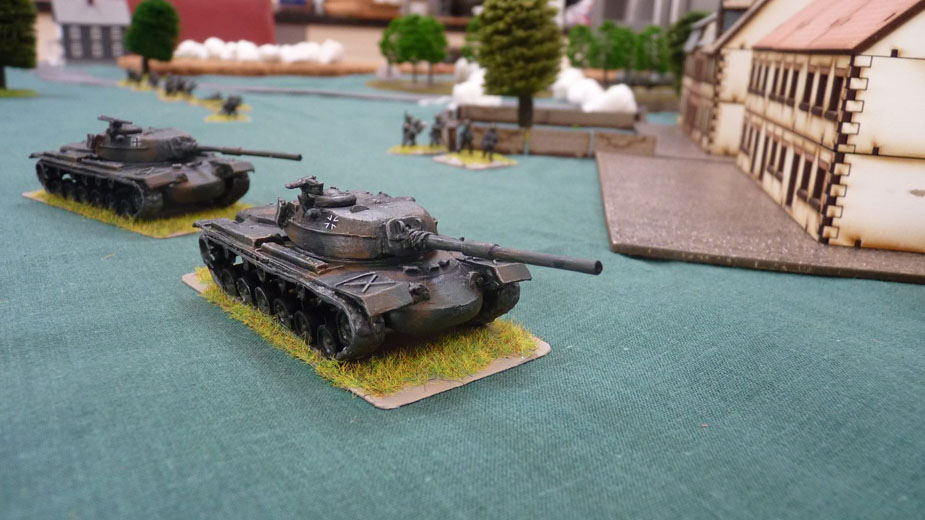 Under no immediate threat, the surviving T64 recovered morale by a level to Uncertain meaning that it could advance if it passed a motivation test. At the same time the Soviet 1st platoon saw its morale drop to uncertain.
Under no immediate threat, the surviving T64 recovered morale by a level to Uncertain meaning that it could advance if it passed a motivation test. At the same time the Soviet 1st platoon saw its morale drop to uncertain.
Turn 3
The loss of the tank with the mineroller made the original plan to go through the minefield much riskier, so a change was needed. The remaining T64 passed its motivation test and advanced into a cornfield followed by the 3rd platoon. The 2nd platoon advanced through the wood. The 1st and support platoons held their ground and fired at the withdrawing Germans, causing a morale test. Failure would mean rout but the critical test was passed.
The M48s continued their redeployment and the West German 2nd platoon continued its fighting retreat with some ineffective firing as they went.
The Soviet tank and 1st platoons recovered their morale meaning that all Soviet morale was Good again.
At this point the smokescreens dissipated leaving a better view of the battlefield.
Turn 4
Firing continued at the Germans in the village with little effect. The Soviet 2nd platoon reched the edge of the wood and fired into the village, again with little effect.
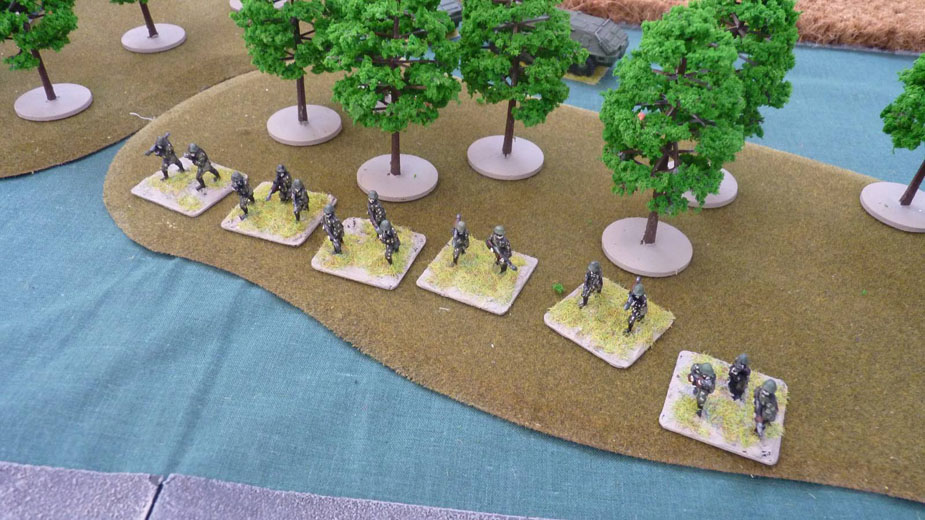 The M48s rounded the right end of the village and moved into sight of the Soviet forces. One tank was able to fire but missed a BTR.
The M48s rounded the right end of the village and moved into sight of the Soviet forces. One tank was able to fire but missed a BTR.
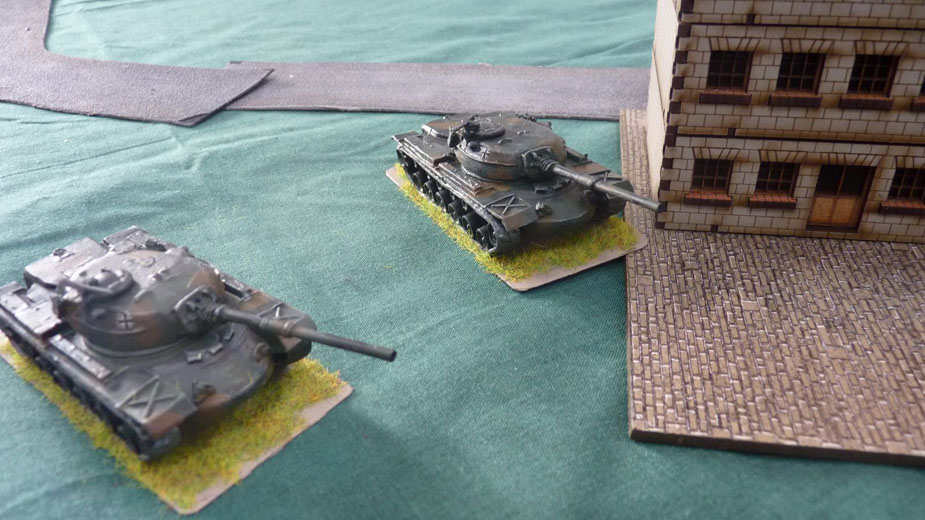 The removal of the smoke allowed the West German 1st platoon a good view of the Soviet units in front of the village and they opened fire to good effect destroying a pair of BTRs with Milans and a rifle group with small arms at extreme range.
The removal of the smoke allowed the West German 1st platoon a good view of the Soviet units in front of the village and they opened fire to good effect destroying a pair of BTRs with Milans and a rifle group with small arms at extreme range.
Turn 5
The BTRs from the 2nd platoon advanced around the northern edge of the central wood as the tank and the BTRs of 3rd platoon fired at the West German 1st platoon. The Soviet 1st platoon advanced on the village to put pressure on the defenders and to try to escape the threat from the M48s. The support platoon continued to fire machine guns and grenades into the village.
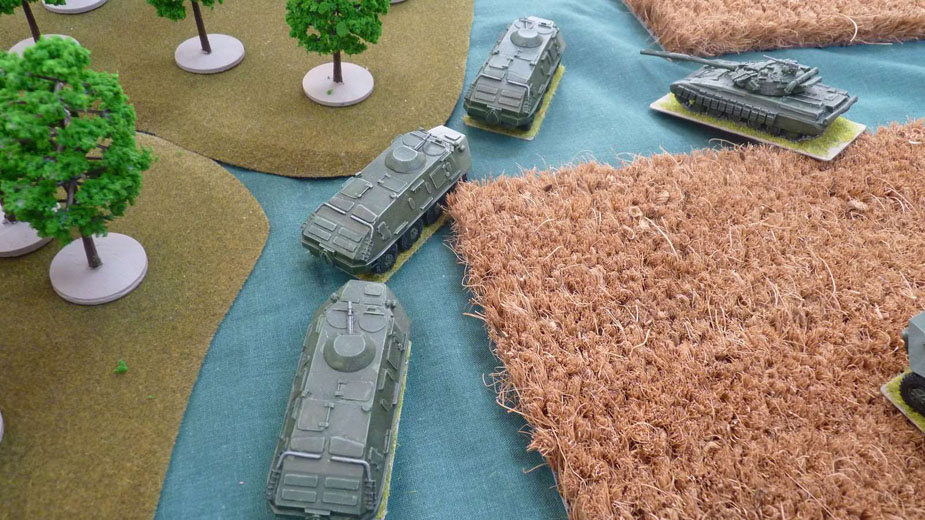 Devestating fire from the West German 1st platoon resulted in the Soviet 1st platoon being reduced to just 1 BTR. Remarkably it passed its morale test. An M48 destroyed the last BTR in the support platoon.
Devestating fire from the West German 1st platoon resulted in the Soviet 1st platoon being reduced to just 1 BTR. Remarkably it passed its morale test. An M48 destroyed the last BTR in the support platoon.
Turn 6
Ignoring the M48s, the automatic grenade launchers maintained their fire on the village. They eliminated a rifle group which incurred a morale test. The fail result caused the West German 2nd platoon to rout. As they were no longer needed to attack the village, the Soviet 2nd platoon turned 90 degrees and advanced through the wood towards the remaining German platoon.
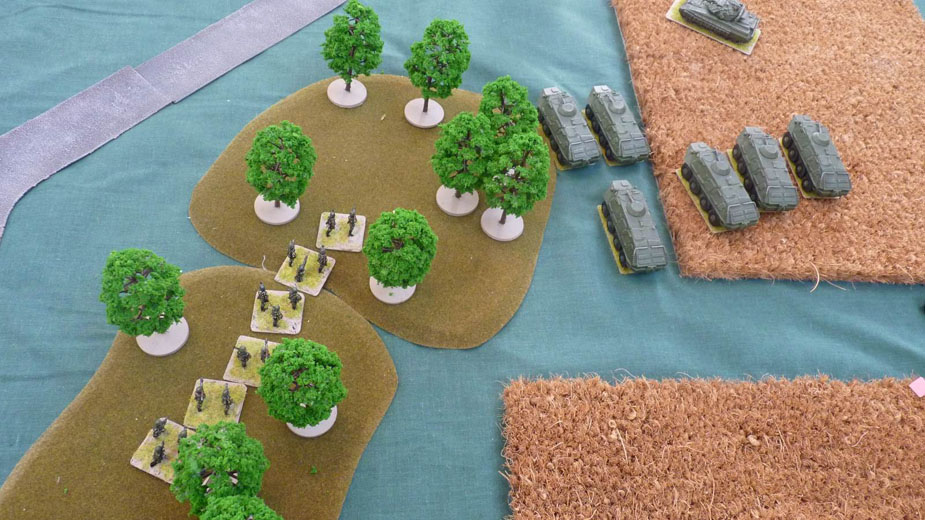 An M48 completed the destruction of the Soviet 1st platoon with a hit on the last BTR, then both tanks advanced on the Soviet support platoon.
An M48 completed the destruction of the Soviet 1st platoon with a hit on the last BTR, then both tanks advanced on the Soviet support platoon.
Turn 7
The T64 inflicted a kill on the German 1st platoon then moved to outflank the defenders. The BTRs of 2nd and 3rd platoon moved forward firing as the former's infantry continued through the wood.
The M48s destroyed a grenade launcher as they closed on the support platoon. Milans knocked out a pair of BTRs from the 2nd platoon.
Turn 8
The T64 eliminated one of the Milans and the German infantry's morale fell to Uncertain.
Under the stress of combat the surviving Milan missed a BTR.
Turn 9
Soviet fire had no effect on the German infantry who hastily moved their ant-tank elements into better firing positions as the Soviets moved to the German left flank.
The M48s advanced through the wreckage of the Soviet 1st platoon aiming to wipe out the Soviet support platoon and maneouvre behind the rest of the Soviet force.
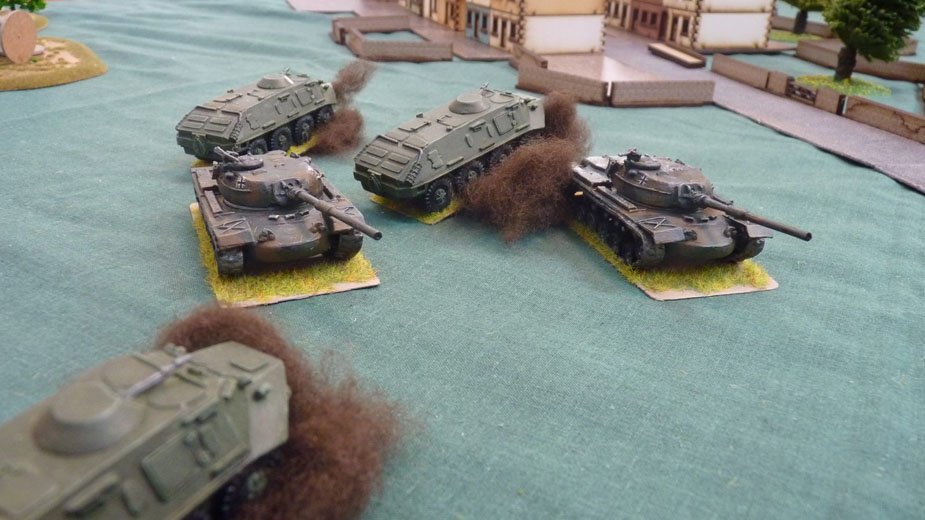
Turn 10
Heavy machine gun and tank fire destroyed the last Milan and a rifle group. The German morale fell to Withdraw. As they pulled back the Germans fired at the Soviet infantry who reached the near edge of the wood inflicting 2 kills and a suppression.
An M48 spotted the Soviet command vehicle behind the wood in the south where it had been hiding since Turn 1. A 105mm shell hit the side and the BTR blew up killing all the occupants including the Soviet commander. This was a serious loss as it meant a morale test for the whole Soviet force with a risk that the attack could be halted. Also, as a 'Centralised' army, the Soviet ability to act could be adversely affected for the rest of the game. The resulting Soviet company morale test was passed but we had to wait for the efrect of the loss of the commander.
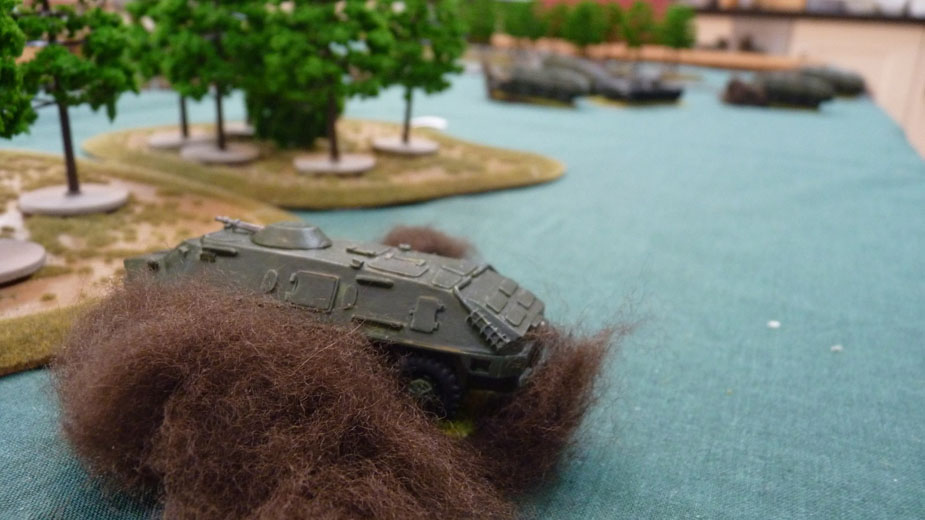
Turn 11
As the German infantry withdrew they continued to attract fire. A neutralisation inflicted a morale test which was failed and the platoon routed. The West German compnay morale dropped to Uncertain.
The M48s finished off the Soviet support platoon then drove back towards their baseline on the road. The games rested on the Soviet company morale and whether the M48s could do enough to stop the breakthrough.
Again the Soviet company morale test was passed.
Turn 12
The Soviet 3rd platoon, its infantry still in their BTRs, advanced toward the German baseline as the tank and the infantry of 2nd platoon prepared to meet the M48s.
The M48s moved forward in a desparate bid to intercept the breakthrough.
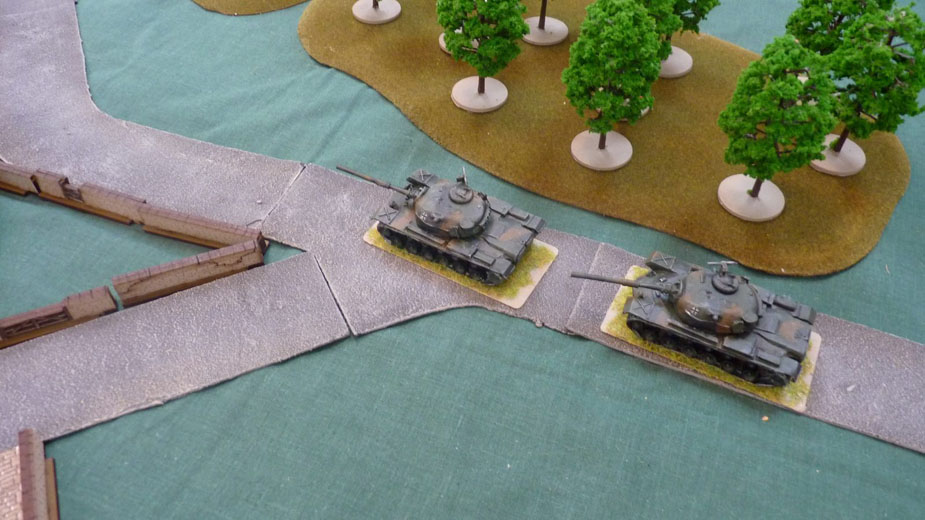
Turn 13
The M48s drove into an ambush and the lead tank was hit by an RPG16. This loss was sufficient to end the game.
Verdict
The Soviets achieved a breakthrough but at a very heavy cost. Only 15 elements - 1 tank, 4 APCs and 11 infantry groups - would make it off the table - and would be without a commander. If it was a Soviet victory it was a Pyrrhic one at best.
We made a few tactical observations:
1. The Soviet quick deployment and firepower concentrated on the village ensured the rout of the West German 2nd platoon, but they were targets for the West German 1st platoon once the smoke cleared and the M48s were able to move against them.
2. The West German 1st platoon had a good firing position but the Soviet tank and BTRs were able to move around its flank as the German infantry tried to move its anti-tank weapons to fire.
3. The Soviets failed to shield their attack on the right effectivley with smoke. The loss of 75% of their tanks including the mine-clearer enforced a change of plan and possibly prevented a quick and large breakthrough.
4. The M48s used their mobility well, but their lack of speed and stabilisation were noticeable.
Return to Battle Reports
















